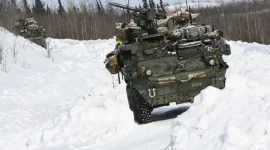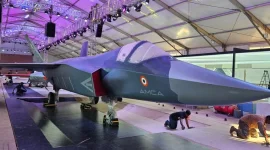Hindustan Aeronautics Limited (HAL) is significantly advancing the capabilities of its unmanned combat aerial vehicle (UCAV) programme, with the 2-ton CATS Warrior loyal wingman drone set to be equipped with the indigenous Astra Mk1 beyond-visual-range air-to-air missile (BVRAAM).
This development promises to reshape the Indian Air Force's (IAF) operational tactics by enabling long-range strikes while working in tandem with manned fighter aircraft like the Sukhoi Su-30MKI and HAL Tejas.
The CATS (Combat Air Teaming System) Warrior, designed as a "loyal wingman," is an unmanned aircraft intended to fly alongside and support piloted fighter jets. Its evolution includes the integration of sophisticated weaponry and advanced electronic systems.
The UCAV is being adapted to carry not only the Advanced Short-Range Air-to-Air Missile (ASRAAM) but also the domestically developed Astra Mk1. This enhancement in payload capacity and guidance systems aims to extend the IAF's combat reach and destructive power, crucially allowing human pilots to remain at safer distances from hostile areas.
A key aspect of the CATS Warrior's ongoing development is its armament capabilities. First displayed at Aero India 2021 as a stealthy drone with low-detection characteristics, the Warrior's design has since been refined to improve its versatility in combat.
Notably, its external mounting points, or hardpoints, located under each wing, can now each carry 170 kg of weaponry. This upgrade allows for the integration of the Astra Mk1 missile, which is guided by radar and weighs approximately 154 kg.
Further enhancing its combat effectiveness, the CATS Warrior incorporates an Internal Weapons Bay (IWB). This feature allows munitions to be carried within the aircraft's body, contributing to its stealth by reducing its radar signature.
The drone boasts a total weapons payload capacity of 650 kg. This is distributed with two 155 kg payloads in the internal bay and a total of 340 kg across its two wing hardpoints (170 kg each). Such a configuration permits the Warrior to be armed with a flexible combination of weapons suitable for various mission requirements, from close-quarters air combat to engagements at extended distances.
The internal bay is planned to carry precision-guided weapons like the Smart Anti-Airfield Weapon (SAAW), developed by the Defence Research and Development Organisation (DRDO), while the external hardpoints will facilitate its air-to-air combat role with missiles such as the Astra Mk1 and ASRAAM.
The incorporation of the Astra Mk1 BVRAAM, a product of DRDO, significantly elevates the CATS Warrior's combat status, enabling it to engage targets beyond the pilot's direct line of sight. A Beyond Visual Range Air-to-Air Missile allows aircraft to engage enemy fighters from considerable distances, typically tens of kilometres away.
The Astra Mk1, with an operational range reported between 80 and 110 kilometres (depending on launch altitude) and equipped with active radar homing for terminal guidance, is engineered to intercept enemy aircraft at these standoff ranges. This capability was previously exclusive to manned fighter jets such as the Su-30 MKI and Tejas. The Astra Mk1's weight of 154 kg is well within the Warrior's 170 kg per-wing hardpoint limit, meaning the UCAV can carry two such missiles externally.
A critical technical consideration is how a radar-guided missile like the Astra Mk1 will be operated by an unmanned platform. Two primary methods are envisaged.
Firstly, the CATS Warrior could be fitted with its own compact Active Electronically Scanned Array (AESA) Fire Control Radar (FCR). This would grant the drone the ability to independently detect, track, and engage targets, potentially using a scaled-down version of the Uttam AESA radar developed for the Tejas fighter.
Such an addition would increase the Warrior's autonomy, transforming it into a more independent combat system capable of BVR strikes without continuous direction from its manned partner.
Alternatively, the Warrior could utilize datalink guidance from its "mothership," such as a Tejas or Su-30MKI, which are equipped with powerful AESA radars. In this Manned-Unmanned Teaming (MUM-T) approach, the manned fighter, operating from a safer distance behind the front lines, would use its own radar to identify and track targets.
This target information would then be relayed in real-time to the CATS Warrior via a secure datalink. The Warrior would then launch the Astra Mk1, with the missile's onboard active radar seeker activating in the final phase of flight to lock onto and intercept the designated target.
This collaborative approach is central to the CATS programme's philosophy, aiming to amplify the sensor capabilities of manned aircraft while reducing risk to pilots in heavily defended airspaces.
The CATS initiative, a broader effort by HAL and its partners including NewSpace Research & Technologies, represents a strategic move towards incorporating advanced autonomous systems into India's defence forces, bolstering national security and promoting self-reliance in critical defence technologies.


